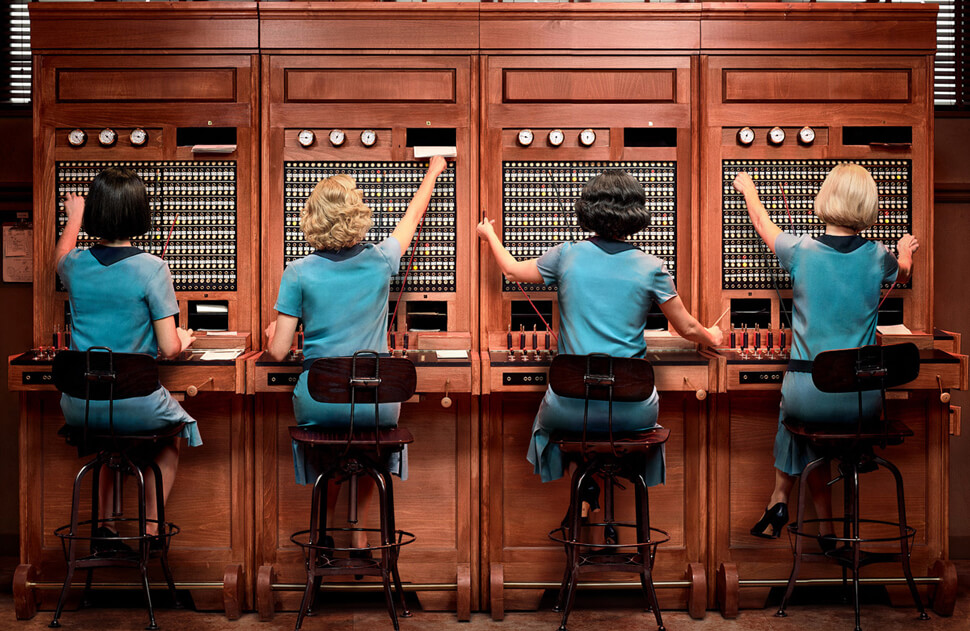Netflix writers have looked back to tell us the role of women in the late 1920s in our country. And they have done so through one of the few professions to which women could opt at that time and thanks to which they began to enter the labor market: the telephone operators.
The lives of Alba, Ángeles, Carlota and Marga cross the day they start working for the most important telecommunications company in Madrid, located in the Telephone Building of the Gran Vía and, since then, will not be the same again.
In a changing Madrid, in which women began to fight for their freedom and their rights, even in a clandestine situation, “Cable Girls” shows precisely this reality. The effort of the main characters to turn their lives, demonstrate their strength and their worth, and the ability to advance on their own (without relying on a possessive husband or a rich and controlling father) is evident from the beginning of the series.
Telephone communication, essential for people and businesses
We have to go back a long time to locate the origin of telephony. It was at the end of the 19th century when the first telephone device was invented. Since then, communication over the phone has been part of the daily lives of people and businesses, becoming essential for them.
Telephone communication has made it possible to maintain contact and transmit messages regardless of distance and location. Undoubtedly, one of the great moments in “Cable Girls” in this sense is the establishment of the first intercontinental call between Spain and the United States. It was a milestone in 1928, becoming an everyday occurrence just over a century later.
The key role of the telephone operators
At the end of the 1920s, access to the profession of telephone operator was not easy. In addition to complying with the requirements to attend the competitions, which included being single, between 18 and 27 years, not wearing glasses or be able to separate the arms 1.55 meters, women had to perform a typing test and a test with the headphones.
For the subscribers, they were mere nameless employees who answered the calls by identifying themselves with their operator number. However, they were the key piece in the phone companies. Organized in three working shifts (morning, afternoon and night), the telephone operators were in charge of operating the gears of the manual telephone PBXs, facilitating communication between people and companies. From calls to alert a fire to institutional calls key to a country’s international policy. Everything was in the hands of the phone operators.
How telephony has evolved in the 20th century
In the manual PBXs the distribution of calls was made with operators who were in charge of the connection of the pins in the network in the corresponding jacks. Thus, the person who made the phone call first contacted the operator, who was responsible for connecting the plug to the corresponding socket of the person to whom the call was sent.
However, this method of communication was not feasible when the number of subscribers to telephone companies began to grow. After more than 100 years of existence, the ‘telephone operators’ ran the risk of disappearing to be replaced by automatic switchboards.
But the growth in the number of subscribers was not the only reason why the telephone companies wanted to make the jump to the automatic PBXs. Business interests also played a prominent role. Communications had to be faster and cost saving. In addition, there was the added value of what would be the first telephone company to create and implement a PBX that could revolutionize the telecommunications sector.
The 21st Century: Virtualization of Communications
In just over a century, telephone PBXs have evolved in an unstoppable way and today continue to be an essential element in the telecommunications network, especially in the business field. Companies and organizations need to communicate with their customers quickly, flexibly, economically, easily and 24/7. And all this is possible thanks to cloud technology (something that in 1928 could not even have imagined), which multiplies the possibilities of communication and productivity of companies.
“Cable Girls” has now become a complete corporate telephony system aimed at promoting the competitiveness of organizations through the best voice technology. When the call is picked up, the caller no longer listens to the operator’s identification number, but rather a recorded message that guides and guides him to the department or the person with whom he wants to speak.
Maybe 20 years from now we will not remember the office of the telephone operators, we may not remember the virtual PBXs as they are now. Companies will continue to invest in R+D to improve their communication processes and thus offer services that meet the needs of their customers. Perhaps devices arising from artificial intelligence or virtual reality become the next virtual PBXs.
What we do know is that today the main characters of “Cable Girls” Alba, Ángeles, Carlota and Marga, would be virtual receptionists and would be in the cloud.
 Subscribe
Subscribe
 Ask for a demo
Ask for a demo

 4 min
4 min
